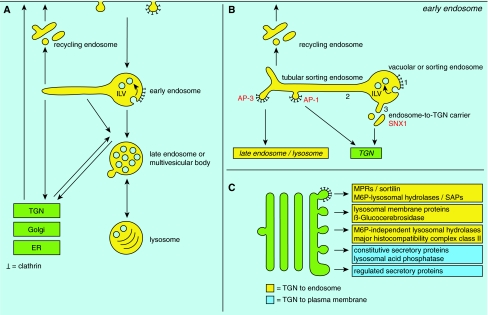Fig. 3.
Sorting and transport within the biosynthetic and endo-lysosomal pathways. a Schematic representation of the interplay between the biosynthetic pathway and endo-lysosomal system depicting the main endosomal compartments that are discussed in the text. b Detailed overview of the various sorting steps at the early endosome. At the endosomal vacuole or sorting endosome, receptor–ligand complexes destined for degradation accumulate in the bilayered clathrin coat (1), upon which they are sorted into intraluminal vesicles (ILV) that form by inward budding of the vacuolar limiting membrane. Recycling cargo by default enters the membrane tubules of the tubular sorting endosome (2) from which it can recycle back to the plasma membrane via the recycling endosome, or is actively sorted towards late endosomes/lysosomes (AP-3 pathway for lysosomal membrane proteins) or TGN (AP-1 pathway). A third exit from the vacuolar endosome is provided by the endosome-to-TGN carriers (3) that mediate SNX1-dependent recycling of MPRs and sortilin to the TGN. c From the TGN, multiple pathways arise that mediate transport to the endo-lysosomal system and plasma membrane. It is still an open question to what extent these pathways use different or overlapping molecular machinery and transport carriers. AP adaptor protein complex, ER endoplasmic reticulum, M6P mannose 6-phosphate, MPR mannose 6-phosphate receptor, SAP sphingolipid activator protein, SNX1 sorting nexin 1, TGNtrans-Golgi network

